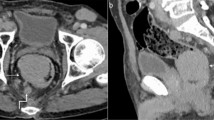Abstract
Objectives
The aims of this study are: (a) to evaluate the reliability of Multidetector Computed Tomography Enteroclysis (MDCT-E) and 99mTc-HMPAO labeled leukocyte scintigraphy (TLLS), in inflammatory bowel disease, (b) to test the accuracy of the two techniques with regard to their histological results, (c) to define how each technique can influence the natural course of inflammatory bowel disease (IBD), (d) to assess the potential value of the two techniques combined.
Materials and methods
Thirty-seven patients with suspected IBD underwent MDCT-E and TLLS. We made a separate assessment of the results shown by the two methods and then compared and contrasted the histological results of the two. The latter, however, were either disappointing or not available in 15 patients who, for this reason, had to be dismissed from the study. As result, the number of participants eventually dropped to 22 subjects: 12 women, 10 men with an average age of 44 years.
Results
MDCT-E and TLLS were successful in all patients. Sensitivity, specificity, and efficiency values have been reported as follows:
-
MDCT-E: 62%, 100%, 64%,100%, 11%, respectively.
-
TLLS: 90%, 100%, 91%, 100%, 33%, respectively.
-
The two methods combined: 95%, 100%, 95%, 100%, 50%, respectively.
Conclusions
The two techniques can be employed in different stages of the natural course of the disease. In our experience, TLLS proved itself to be useful in the diagnosis of the disease and the assessment of its development. Conversely, MDCT-E proved itself to be more reliable in identifying the seat and the extent of the disease inside and outside the bowel wall as well as potential intra-peritoneal and extra-intestinal complications. The combined use of the two methods represents the Criterion Standard for diagnosing IBD with imaging.




Similar content being viewed by others
References
Morson BC, Dawson IMP (eds.) (1979) Inflammatory disorders. Gastrointestinal pathologies, 2nd edn. London, England: Blackwell, pp 272–336
Torkzad MR, Lauenstein TC (2009) Enteroclysis versus enterography: the unsettled issue. Eur Radiol 19:90–91
Drews BH, Barth TFE, Hänle MM, et al. (2009) Comparison of sonographically measured bowel wall vascularity, histology and disease activity in Crohn’s disease. Eur Radiol 6:1379–1386
Di Mizio R, Maconi G, Romano S, et al. (2004) Small bowel Crohn disease: sonographic features. Abdom Imaging 29(1):23–35
Sturm EJC, Cobben LPJ, Meijssen MAC, van der Werf SDJ, Puylaert JBCM (2004) Detection of ileocecal Crohn’s disease using ultrasound as the primary imaging modality. Eur Radiol 5:778–782
Schmidt S, Lepori D, Meuwly JY, et al. (2003) Prospective comparison of MR enteroclysis with multidetector spiral-CT enteroclysis: interobserver agreement and sensitivity by means of “sign-by-sign” correlation. Eur Radiol 13:1303–1311
Schmidt S, Felley C, Meuwly JY, Schnyder P, Denys A (2006) CT enteroclysis: technique and clinical applications. Eur Radiol 16:648–660
Minordi LM, Vecchioli A, Poloni G, et al. (2009) Enteroclysis CT and PEG-CT in patients with previous small-bowel surgical resection for Crohn’s disease: CT findings and correlation with endoscopy. Eur Radiol 19:2432–2440
Alberini JL, Badra A, Freneaux E, et al. (2001) Technetium-99m HMPAO-labeled leukocyte imaging compared with endoscopy, ultrasonography and contrast radiology in children with inflammatory bowel disease. J Paediatric Gastroenterol Nutr 32(3):278–286
Di Mizio R, Rollandi GA, Bellomi M, et al. (2006) Multidetector-row helical CT enteroclysis. Radiol Med 111:1–10
Romano S, De Lutio E, Rollandi GA, et al. (2005) Multidetector computed tomography enteroclysis (MDCT-E) with neutral enteral and IV contrast enhancement in tumor detection. Eur Radiol 15:1178–1183
La Seta F, Buccellato A, Tesè L, et al. (2006) Multidetector-row CT enteroclysis: indications and clinical applications. Radiol Med 111(2):141–158
Hara AK (2009) Swartz PG: CT entography of Crohn’s disease. Abdom Imaging 34:289–295
Mazzeo S, Caramella D, Battolla L, et al. (2001) Crohn disease of the small bowel; spiral CT evaluation after oral hyperidration with isotonic solution. J Comput Assist Tomogr 25(4):612–616
Hassan G, Cerro P, Zullo A, Spina C, Morini S (2003) Comuted tomography enteroclysis in comparison with ileoscopy in patients with Crohn’s disease. Int J Colorectal Dis 18(2):121–125
Jamieson DH, Shipman PJ, Israel DM, Jacobson K (2003) Comparison of multidetector CT and barium studies of the small bowel: inflammatory bowel disease in children. AJR Am J Roentgenol 180(5):1211–1216
Boudiaf M, Jaff A, Soyer P, et al. (2004) Small bowel diseases: prospective evaluation of multi-detector row helical CT enteroclysis in 107 consecutive patients. Radiology 233:338–344
Funda A, Dinçer D, et al. (2008) Technetium-99m hexamethyl propylene amine oxime-labeled leukocyte scintigraphy at three different times in active ulcerative colitis: comparison with colonscopy and clinic-biochemical parameters in the assessment of disease extension and severity. Ann Nucl Med 22:371–377
Charron M, Di Lorenzo C, Kocoshis S (2002) CT and 99m Tc-WBC vs colonscopy in the evaluation of inflammation and complication of inflammatory bowel diseases. J Gasroenterol 37(1):23–28
Miyazaki C, Kubo K, Aoyama H, et al. (1997) Tc-99m labeled leukocyte scintigraphy and CT for the evaluation of patients with inflammatory bowel disease. Nippon Igaku Hoashen Gakkai Zasshi 57(7):395–401
Saibeni S, Rondonotti E, Iozzelli A, et al. (2007) Imaging of the small bowel in Crohn’s disease: a review of old and new techniques. World J Gastroenterol 13(24):3279–3287
Acknowledgments
We are greatly indebted to Carlo Macchia for language consultancy.
Author information
Authors and Affiliations
Corresponding author
Rights and permissions
About this article
Cite this article
Grassi, R., Rambaldi, P.F., Di Grezia, G. et al. Inflammatory bowel disease: value in diagnosis and management of MDCT-enteroclysis and 99mTc-HMPAO labeled leukocyte scintigraphy. Abdom Imaging 36, 372–381 (2011). https://doi.org/10.1007/s00261-010-9652-2
Published:
Issue Date:
DOI: https://doi.org/10.1007/s00261-010-9652-2




